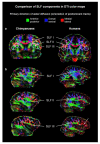Virtual dissection and comparative connectivity of the superior longitudinal fasciculus in chimpanzees and humans
- PMID: 25534109
- PMCID: PMC4324003
- DOI: 10.1016/j.neuroimage.2014.12.039
Virtual dissection and comparative connectivity of the superior longitudinal fasciculus in chimpanzees and humans
Abstract
Many of the behavioral capacities that distinguish humans from other primates rely on fronto-parietal circuits. The superior longitudinal fasciculus (SLF) is the primary white matter tract connecting lateral frontal with lateral parietal regions; it is distinct from the arcuate fasciculus, which interconnects the frontal and temporal lobes. Here we report a direct, quantitative comparison of SLF connectivity using virtual in vivo dissection of the SLF in chimpanzees and humans. SLF I, the superior-most branch of the SLF, showed similar patterns of connectivity between humans and chimpanzees, and was proportionally volumetrically larger in chimpanzees. SLF II, the middle branch, and SLF III, the inferior-most branch, showed species differences in frontal connectivity. In humans, SLF II showed greater connectivity with dorsolateral prefrontal cortex, whereas in chimps SLF II showed greater connectivity with the inferior frontal gyrus. SLF III was right-lateralized and proportionally volumetrically larger in humans, and human SLF III showed relatively reduced connectivity with dorsal premotor cortex and greater extension into the anterior inferior frontal gyrus, especially in the right hemisphere. These results have implications for the evolution of fronto-parietal functions including spatial attention to observed actions, social learning, and tool use, and are in line with previous research suggesting a unique role for the right anterior inferior frontal gyrus in the evolution of human fronto-parietal network architecture.
Keywords: Cerebral asymmetry; Diffusion tensor imaging; Evolution; Laterality; Tractography; White matter.
Copyright © 2014 Elsevier Inc. All rights reserved.
Figures







References
-
- Andersson JLR, Jenkinson M, Smith S. Non-linear optimisation: FMRIB technical report TR07JA1. 2007 from www.fmrib.ox.ac.uk/analysis/techrep.
-
- Aron AR, Robbins TW, Poldrack RA. Inhibition and the right inferior frontal cortex. Trends Cogn Sci. 2004;8(4):170–177. - PubMed
-
- Aron AR, Robbins TW, Poldrack RA. Inhibition and the right inferior frontal cortex: one decade on. Trends Cogn Sci. 2014 - PubMed
-
- Assmus A, Marshall JC, Ritzl A, Noth J, Zilles K, Fink GR. Left inferior parietal cortex integrates time and space during collision judgments. Neuroimage. 2003;20(Suppl 1):S82–88. - PubMed
Publication types
MeSH terms
Grants and funding
LinkOut - more resources
Full Text Sources
Other Literature Sources

